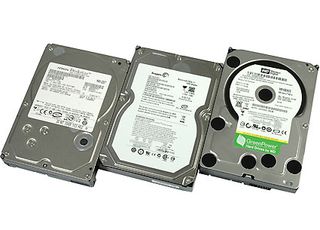The Terabyte Battle
Conclusion

Hitachi, Seagate or Western Digital? Seagate's Barracuda 7200.11 is the fastest, Western Digital's Caviar GP the most efficient, and the Deskstar 7K1000 by Hitachi is far from being left in the dust.
Here we have three drives, three product concepts, and three different outcomes Compare Prices on 1 TB Barracuda 7200.11. All three drives deliver decent sufficient performance to power a modern high-performance PC. Enthusiasts and power users should avoid Western Digital's Caviar GP, as the drive wasn't tuned to perform, but rather to be as energy efficient as possible. From this standpoint, the WD10EACS Caviar GP beats the hell out of its competitors: At only 4.2 W idle power, it requires half the power of the two other terabyte drives. If you intend to equip a datacenter with dozens or hundreds of high-capacity drives, this may very well become an important decision point. The benefits of the decreased power consumption are low heat dissipation, and the quietest acoustics of any 3.5" drive we've had in our test labs.
Hitachi and Seagate battle head to head when it comes to winning the heart of the enthusiast who wants as much performance as possible. The Deskstar 7K1000 still does okay in the access time and I/O performance tests, but it loses ground when it comes to transfer rates. The Barracuda 7200.11 offers the best low-level benchmark results, jumping over 100 MB/s read or write transfer rates and accessing data in an average of 12.7 ms. With the exception of access time and I/O benchmarks, it also clearly beats Western Digital's 10,000 RPM Raptor, and sets the new standard for desktop hard drives. (It's about time for Western Digital to come up with a new Raptor drive. Based on current technology, it should be able to regain everything that has been lost to Seagate right now.)
Anyone who just wants a reasonable high-capacity drive has to consider the Caviar GP, due to its excellent thermals and low power consumption. Users with performance ambitions should go for the Barracuda 7200.11, as it currently offers the best mix of performance, capacity and cost. What about Hitachi? The Deskstar 7K1000 requires a little facelift, but if I could get it for significantly less than the others, I wouldn't refuse it.
Join our discussion on this article!
Stay on the Cutting Edge
Join the experts who read Tom's Hardware for the inside track on enthusiast PC tech news — and have for over 25 years. We'll send breaking news and in-depth reviews of CPUs, GPUs, AI, maker hardware and more straight to your inbox.
-
andy_newton The Barracuda gets bricked after 6 months of use. While Seagate is kind enough to offer a free recovery, I lost 3 weeks of my time waiting. Upon receiving its unbricked with new firmware, the performance has now become terribly slow. It is very much different from the last moments before it got bricked.Reply
I contacted the customer service again and they give me a B.S. regarding this particular hard drive is not suitable foe use as external Drive.
I am both terribly surprised and disappointed that tomshardware did not amend any article regarding its performance (post recovery), since those performance charts with its defective firmware should be invalid.
Instead, Tomshardware continues to praise this hard drive and claims that in toms lab the bricking can not be repeated.
I am wondering how much money that seagate pays toms to shut up and not to publish any honest review regarding this other affected hard drives.
Or is it just me (again) waking up in a parallel universe where Seagate has never built any drives with defective firmware.
-ND -
flagoman mmm, you are out of place on your comments, here, couse i dont think that toms would be able to test any hardware for 6 months or until it fails. imagine how late every review would be delayed, its ridiculous,what you are asking what are you six years old??? shezzz... And the company offer you a recovery of the info of your hdd,and actually i found that a great plus, Seagate. but you should had take your info out, and buy a new one.Reply
Most Popular

